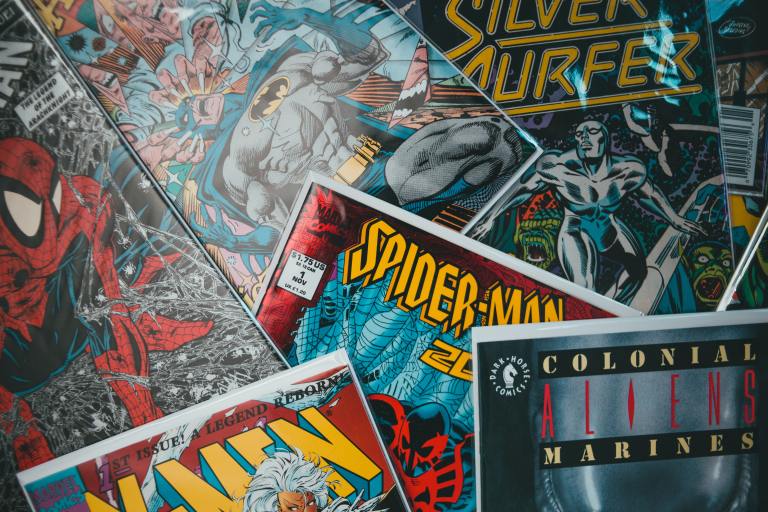Adult Coloring Books: Only Half-Good For Publishing
Even as booksellers cheer added revenue from this year's popularity of adult coloring books, many confuse their success with a rosy message about a "print surge" in books.


Color Us Skeptical
 One of the things the book publishing industry produces best is confusion. Its gray areas (not unlike its Grey areas) are fogs of speculation, partial truths, gossip, and misty-eyed hindsight.
One of the things the book publishing industry produces best is confusion. Its gray areas (not unlike its Grey areas) are fogs of speculation, partial truths, gossip, and misty-eyed hindsight.
Among the most beloved notions this year has been the idea that print books entered a renaissance in 2015. In bookseller’s dreams, consumers backed their cars over e-readers, deleted their Kindle apps from their tablets, and clutched paper books to their bosoms with all-is-forgiven fervor.
This is a concept that lies in the deepest field of publishing’s “murk and contradiction,” as my colleague Philip Jones at The Bookseller has put it. Jones is a man who knows the industry’s capacity for contradiction well. After all, a bookshop owner in southwest England in September told The Bookseller, “The ebook threat is evaporating before us. The print book seems virtually indispensable at this present time and booksellers have a fantastic opportunity here now to seize the moment.”
The doubly disturbing nature of that comment, of course, lies in the how this bookseller seems to think (a) that digital publishing is somehow going away, and (b) ebooks—or any other alternative form of building readership—should be thought of as a “threat.”
Perhaps when the Calgary-based Enthrill Distribution system reaches the US market next year, some shopkeepers might take another look at their own potential sales capacity in digital. Enthrill puts racks of attractive ebook gift cards into bookstores and other retail sites, allowing shoppers in brick-and-mortar stores to pay terrestrial cash registers for digital books they download using codes on those cards. There’s more on that one here, at The FutureBook.
But our English shopkeeper’s tone and outlook are widely echoed in the US. Our industry’s two leading national constituencies, the US and UK, are similarly are shot through with a kind of catch-in-the-throat romance for print.
The book fetish is a hardy thing and few have been able to hear clearly Simon & Schuster’s CEO Carolyn Reidy’s warning that a presumed abatement of the digital “threat” might not signal any real change. “Maybe it’s just a pause here,” she’s quoted by Alexandra Alter in the Times as saying. “Will the next generation want to read books on their smartphones, and will we see another burst come?” Yes, and almost certainly yes.
 Jones turns to Reidy, too, quoting her telling the Book Industry Study Group earlier this year, “The more we know, the more we have to learn.” In other words, it’s probably foolish to take any short-term wobble or pivot as the key to a future that might stand comfortably still for publishing. Jones cautions against making too much of the so-called “print surge,” laying out some of the complexity that the “evaporating threat” people don’t like to discuss:
Jones turns to Reidy, too, quoting her telling the Book Industry Study Group earlier this year, “The more we know, the more we have to learn.” In other words, it’s probably foolish to take any short-term wobble or pivot as the key to a future that might stand comfortably still for publishing. Jones cautions against making too much of the so-called “print surge,” laying out some of the complexity that the “evaporating threat” people don’t like to discuss:
Five years ago, the ebook was set fare to crush everything before it. The narrative has now reversed itself. Yet if I felt troubled by the earlier view, the new talk worries me even more. Reidy’s rejoinder is key: we do not know enough to be so definitive in our analysis, and what we do know does not tell one story.
There are numerous factors affecting the e-book market, most of which won’t fit neatly into a headline, and some of which will impact different parts of the business at different times. The shift to agency pricing (in some cases, publishers have priced their ebooks higher than the price Amazon charges for the print versions); the rise in sales of indie-authored, low-priced ebooks; device fatigue and a slow renewals cycle; a lack of good competition to Amazon; adoption rates decreasing; reading time diminishing; and output reaching saturation point. By contrast, colouring-in, a strong fiction release programme, and a more confident high street are making print bob-up with the Nielsen TCM rising 4.6% in 2015.
Robert McCrum’s widow’s walk at The Guardian—straining at the horizon to spot “Modernism 3.0″—has a lot of good hope to it, and it’s a fine read. But it’s worth noting that even as sharp a guy as McCrum seems to see the rise of a new direction in literature more likely, apparently, “with all kinds of print flourishing, and the digital tide receding, as the e-boom stalls and hardbacks rally.”
Foggy stuff, this idea that good literature might need paper to surface. And McCrum isn’t really guilty of this, he does allow that our next great moment may come from any direction.
But comments on the piece indicate a frustration with the widely shared unwillingness to say that a yarn told on an electronic device is every bit as good in terms of narrative technique and potential as one told on paper.
One commenter writes: “I don’t understand, and am in truth frustrated by, this paper’s determination to equate content with format. It doesn’t matter at all if people are reading in print or on e-readers. What matters is that they are reading at all, and secondly what it is they’re reading.”
How quickly we wander into the haze of what Reidy refers to as publishing’s “peculiar logic.”
‘Print book sales aren’t surging’
“Sorry, but print book sales aren’t surging,” writes Jane Friedman in her walkup to the new edition of The Hot Sheet, a specialized newsletter for authors that she and I produce.
Hardcover sales are down more than 10 percent this year. As Michael Cader pointed out in Publishers Lunch, “Print sales are down more [than ebook sales] in percentage terms, and down more in aggregate dollars.” Across the board, overall sales volume hasn’t changed much: in 2015, print sales are up 2 percent, just as they were in 2014, according to Nielsen Bookscan data.
In our newsletter, we take on the question directly, “Was 2015 A Good Year For US Print Book Sales?” The conclusions might surprise you.
David Montgomery, Publishing Technology
What Friedman does in her walkup to The Hot Sheet’s release is point out that Barnes & Noble doesn’t look like a major bookstore chain in a flourishing print environment, does it? “Since August 2015,” she writes, B&N’s “stock has dropped 67 percent. In 2013, the bookseller said they planned to close about one-third of their 689 stores over the next decade.”
And the print patch of fog billowing around publishing these days is made all the more opaque by this “sudden” (unless you were paying attention) rise of popularity for adult coloring books.
The Adult Coloring Book ‘Phenomenon’
 Judith Rosen’s Coloring Books Grow Up in May painted—maybe crayoned—a picture of publishers scrambling to keep up with demand. “Getting these titles to shelves is one of the biggest challenges facing U.S. publishers, who are having a hard time keeping up with the adult coloring book phenomenon,” Rosen wrote. “Although growth was steady over the past year, it’s been explosive this spring.”
Judith Rosen’s Coloring Books Grow Up in May painted—maybe crayoned—a picture of publishers scrambling to keep up with demand. “Getting these titles to shelves is one of the biggest challenges facing U.S. publishers, who are having a hard time keeping up with the adult coloring book phenomenon,” Rosen wrote. “Although growth was steady over the past year, it’s been explosive this spring.”
All the more reason that it’s been funny to see various sectors of the industry itself catch on. A long-standing industry list-serv discussion group “discovered” the adult coloring books just before Christmas, despite their growing numbers and coverage all year. One of the hipper members of the group had to tell a less well informed one that it’s much too late to do anything about the “adult coloring book” phrase. This horse is way of the barn.
At this writing, Amazon’s Bestsellers listings put a coloring book at No. 1: Stress Relief Coloring Book: Garden Designs, Mandalas, Animals, and Paisley Patterns at No. 1. It sells for $3.19. What a utilitarian title, no? And apparently adult coloring books have adopted diet books’ tradition of pamphlet-length subtitles.
The No. 1 seller lists Adult Coloring Book Designs as its author and publisher. The book stands, at this writing, at No. 14 overall, a prodigious ranking on Amazon, and at No. 2 among new releases. (Pablo Hidalgo’s Star Wars: The Force Awakens Visual Dictionary currently is at No. 1 among “Hot New Releases.” Someday, I hope to see a listing of Cold New Releases, don’t you?)
In fact, eight of the 40 top Hot New Releases on Amazon.com, as this story posts, are coloring books, including the Swear Word Coloring Book: Relaxation Series: Coloring Books for Adults.
I can’t think of a better way to relax than by coloring swear words, can you?
The fact that Swear Word is a self-published entry—authored by “Swear Word Coloring Book,” get the pattern?)—tells you that the struggle to keep up with demand that Rosen reported at Publishers Weekly in May now has been met, in the usual trajectory, by an onslaught of quickly produced, low-priced content in the idiom.

Certainly, it’s springtime for talented Johanna Basford, the Scottish illustrator some now dub the “queen of coloring.” Her many successes include the Secret Garden 2016 Wall Calendar: An Inky Treasure and 2016 Coloring Calendar (what did I tell you about these subtitles?); Lost Ocean: An Inky Adventure and Coloring Book; and Enchanted Forest: An Inky Quest & Coloring Book. She’s hardly self-publishing; her work has been published by the UK’s Laurence King and by Penguin Random House. King’s staff tells Publishers Weekly’s Jim Milliot that Secret Garden and Enchanted Forest together have sold together more than 13 million copies. Her titles’ minimal text are translated into some 40 languages.
And as our #PicturesMeanBusiness friend, the illustrator Sarah McIntyre, might well agree, it’s great to see illustrators getting so much work, especially when they’re properly credited.
But that puffery of publishing fog you see gassing around these coloring books come in two densities:
- There’s the idea that adult coloring books’ popularity mean “print is back.” No, they mean that coloring is back. They’re paper, sure. But coloring books are to real books what scooters are to bicycles.
- There’s the idea that adult coloring books will build readership. No, they’ll build coloring-ship. The colorists are perfectly lovely people, and no one is questioning their right to color every single spot of white space they can find in their lives. But this is not reading. And the world of books needs new readers.
If sales of these things bring money into publishing, we’re all glad. If publishers then turn that money around and help cultivate and develop the work of authors and their outreach to readers, we’ll be gladder. (Yes, it’s a word.)
However, thinking of adult coloring books as part of book culture is a shade beyond your Crayola Burnt Sienna. Adult coloring books are novelty items. And some have suggested that it’s pretty ominous for our society to think that our adults are so impressed with their stress levels that they’re turning to children’s arts and crafts.
Adult coloring books are related to books as, maybe, wall posters and bath towels with Charles Dickens’ likeness on them are related to books. They fit well with the “lifestyle” direction recently described by Barnes & Noble’s leadership. This is merchandising in the no-need-to-read-anything sense. Not literature.
‘In Parallel’
There’s a lot of clear thinking in Publishing Technology’s David Montgomery’s comments on 2016. He starts by pointing out that our inability to adequately track ebook sales (especially self-published ones) is part of the reason that print might seem to be gaining: “Even if the major trade publishers are selling fewer ebooks,” he writes, “it doesn’t follow that the overall digital book market must be shrinking. It could just mean that major publishers’ releases now account for a smaller portion of the total ebook market.”
And in the longer view, he warns, as we’ve done in the past, of a bifurcating industry and market:
There isn’t one book market anymore: there are two, and they exist in parallel.
One continues to be dominated by major publishers, and increasingly uses agency pricing as a strategy to support print book sales.
The second publishing market is almost exclusively made up of ebooks, and is driven by Amazon-published and KDP content sold at a substantial discount to the product produced by traditional publishers.
This is why you should carry along a big grain of sea salt with you for when someone tells you that coloring books somehow help bolster the idea of a “print surge.” They’re glad, understandably, for any pile of colored pencils that might help them prop up the idea that digital reading isn’t here to stay.
And any assertion that adult coloring books indicate the health of reading or book culture in general is a matter of drawing a bad bright line between the two worlds, digital and print, just when they need to come closer together, not fly apart.
It’s enough to bring some colorful swear words to mind.![]()
The Hot Sheet is a new biweekly newsletter for professional career authors from Porter Anderson and Jane Friedman. It is available by subscription.




